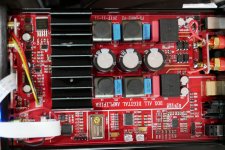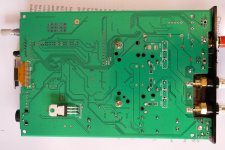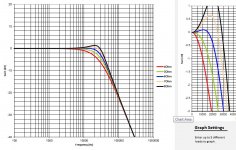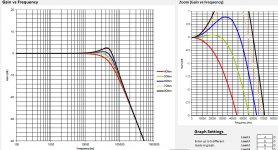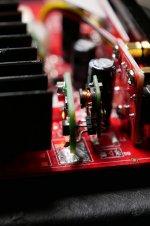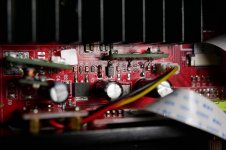Your sim is wrong as I pointed out but 10uH might be better for this amp. 22uH works well in D802. I will eventually remove an inductor from the V200 and measure it before ordering any replacements. I'm not really very interested in it at the moment because it sounds dull as it is and needs a lot of work, not just inductors. I actually think I made a bad choice to buy it.
I have made my first mods to the D802 I replaced the xo with a Rojon tcxo and removed the front button connector (red, black, yellow wires) so I can fit a taller cap there in due course. The wire is a little tight but acceptable.
I replaced the xo with a Rojon tcxo and removed the front button connector (red, black, yellow wires) so I can fit a taller cap there in due course. The wire is a little tight but acceptable.
I have also spent a little time listening and HiFi mode defeats all the chosen eq settings, incl "flat". So I guess this is the pass through mode. It sounds more dynamic with better vocals than "flat" anyway.
The claimed phase noise of the Rojon. Decent if true. I will spend some time now working (yes really) and listening

I have made my first mods to the D802
I have also spent a little time listening and HiFi mode defeats all the chosen eq settings, incl "flat". So I guess this is the pass through mode. It sounds more dynamic with better vocals than "flat" anyway.
The claimed phase noise of the Rojon. Decent if true. I will spend some time now working (yes really) and listening

Attachments
Last edited:
Hugh Jazz, but what could be wrong with such trivial simulation yet where are only linear components? Are you kidding me? )) I guarantee you'll get around -3db at 20kHz if will go with 22uH coils and 1uF capacitor in full-bridge(or 44uH - 1uF in Half-bridge) if load impedance 4-6ohm, it is like 2+2=4  I could agree if someone may like such roll-off but it is another story.
I could agree if someone may like such roll-off but it is another story.
The error appears to be at least 2 things - the speaker has a crossover with 3.9uF and 0.68R in series with the tweeter so the sim's resistance looks too low, (one might argue that the woofer and its inductor should also be in the sim, along with back emf and the like, but ... no need for this I suppose) and the output filter should be common mode with 2x 1uF caps to ground and differential with 0.22uF across the speaker. Then we'll see if your sim differs from Ti's result with the same.
Attachments
Last edited:
The plot in post 527 above is from Texas Instruments filter calculator and shows a filter apparently designed for six ohms. This is the same filter that is in the D802 and the same filter that I described above - 22uH with 1uf common filter caps and a 0.22uF differential filter cap. When the impedance of the Q100 tweeter is added to its crossover it is roughly six ohms. From the maths and measurements, the D802 and Q100 are a pretty good match and it sounds that way too. So, it seemed to me that you had not done the sim correctly because it showed a significant roll off which would be easy to hear. In fact, I'm simply repeating what I said in post 511 - that 22uH plus a common mode filter of 1uF is a good match for Q100.
The V200's filter is unknown to me at this stage. Guessing it is 10uH and 0.47uF differential, it is suitable for 5 ohm tweeters according to the Ti calculator. Screenshot attached. I'm assuming the reason the sound is somewhat dull is that the spdif receiver is the high jitter CS8416. That has an xo so perhaps upgrading the xo to something with low phase noise might help. As I said before, it looks like the inductors are only a small part of the problem.
The V200's filter is unknown to me at this stage. Guessing it is 10uH and 0.47uF differential, it is suitable for 5 ohm tweeters according to the Ti calculator. Screenshot attached. I'm assuming the reason the sound is somewhat dull is that the spdif receiver is the high jitter CS8416. That has an xo so perhaps upgrading the xo to something with low phase noise might help. As I said before, it looks like the inductors are only a small part of the problem.
Attachments
Last edited:
Hi
Which cutoff frequency is to set?
Weeks ago i had the same questions.
https://www.diyaudio.com/forums/class-d/309813-wrong-tpa3255-37.html#post5537636
i use about 40khz....with hybrid and its fitting for the 4 R impdeance
Which cutoff frequency is to set?
Weeks ago i had the same questions.
https://www.diyaudio.com/forums/class-d/309813-wrong-tpa3255-37.html#post5537636
i use about 40khz....with hybrid and its fitting for the 4 R impdeance
Depends on the amp, speakers and some might say source too. If you want a rule of thumb I'd say design for 60KHz and 6 ohm, but I'd never do this. If I wanted a universal filter, I'd start at either 10uH or 15uH and 0.47uF differential, depending on the speakers, and see how it sounds.
40KHz and hybrid makes a lot of sense to me. How does percussion sound?
40KHz and hybrid makes a lot of sense to me. How does percussion sound?
Last edited:
Hi Hugh Jazz
i am not so experienced as you or others. i just follow the hint as described above. currently i am happy with the setup for 4 ohms.
i tried
7µ and 1µ
7µ and 0,68µF
7µ and 0,68 + CTL 0,033µF - original opamp (TL072 or fake )
)
now i use 7µH + 1µ again with new OPA1602 or AD8599
percussions was never a problem. the KEF Q100 is a coax which sound pointed but partly hard....and very good for that price !
so for this speaker it would be make sense to cut of -3dB at 20kHZ...i will try if i have time to change amps and speakers...but not in this thread
but as jean paul decribed. china boards(amps) are.... cheap +cheap +cheap..
i am not so experienced as you or others. i just follow the hint as described above. currently i am happy with the setup for 4 ohms.
i tried
7µ and 1µ
7µ and 0,68µF
7µ and 0,68 + CTL 0,033µF - original opamp (TL072 or fake
now i use 7µH + 1µ again with new OPA1602 or AD8599
percussions was never a problem. the KEF Q100 is a coax which sound pointed but partly hard....and very good for that price !
so for this speaker it would be make sense to cut of -3dB at 20kHZ...i will try if i have time to change amps and speakers...but not in this thread
but as jean paul decribed. china boards(amps) are.... cheap +cheap +cheap..
I changed the 12v and 3.3V regulators, added a 47uH inductor for the 3.3V, and replaced caps in the D802 - and am very impressed with the sound now - that Rojon tcxo is good but it needed better power. I also got rid of the blue LEDs behind the volume dial - tacky. A minor re-route of the red/yellow/black button wires too.
The LM2596 and its bits are gone and instead there is a 550kHz switcher set to 12.8V that is fitted with an LT3045 set to 12V with fast start up and Cset of 22uF. I removed the diode (D3) that feeds 12V to the 3.3V reg and fitted a 47uH inductor. The 3.3V LM317 and its bits were removed and replaced with another LT3045. I'm using a linear power supply for the amp. The three 470uF caps were replaced with 1000uF Pansonic FR 16V, Rubycon 1200uF ZLH 6.3V and 1500uF 6.3V ZLJ.
Not much else worth doing to this amp now but it does sound really good. I'm impressed and very pleased
I opened up the V200 again and pulled the coils - they are 11uH on my meter. I'll order some 10uH, some KDS xo, and a PCM1803 and then get to work on that. Can it sound as good as the D802....?
The LM2596 and its bits are gone and instead there is a 550kHz switcher set to 12.8V that is fitted with an LT3045 set to 12V with fast start up and Cset of 22uF. I removed the diode (D3) that feeds 12V to the 3.3V reg and fitted a 47uH inductor. The 3.3V LM317 and its bits were removed and replaced with another LT3045. I'm using a linear power supply for the amp. The three 470uF caps were replaced with 1000uF Pansonic FR 16V, Rubycon 1200uF ZLH 6.3V and 1500uF 6.3V ZLJ.
Not much else worth doing to this amp now but it does sound really good. I'm impressed and very pleased
I opened up the V200 again and pulled the coils - they are 11uH on my meter. I'll order some 10uH, some KDS xo, and a PCM1803 and then get to work on that. Can it sound as good as the D802....?
Attachments
Last edited:
Hello
Do you think that I could use an FX D802 to power some PA speakers? They would be very efficient - 99 or 100db sensitivity (1w 1M). Two way speakers with 15" + Compression driver. Either 8ohm or 4 ohm.
I wouldn't need it for serious party volumes, but mainly for background music outside. I'm thinking 24v battery power for a mobile solution.
Do you think that I could use an FX D802 to power some PA speakers? They would be very efficient - 99 or 100db sensitivity (1w 1M). Two way speakers with 15" + Compression driver. Either 8ohm or 4 ohm.
I wouldn't need it for serious party volumes, but mainly for background music outside. I'm thinking 24v battery power for a mobile solution.
I've been researching FDA amps, and I see that most of them offer a variety of EQ presets as well as tone controls. Do any of these amps offer manual EQ adjustments with a graphic equalizer? I see the Alientek D8 has some sort of visualizer, but it appears it is only aesthetic.
Well, I've just taken delivery of a D802C PRO. It looks like a nice little unit.
However, the Bluetooth is next to useless. It has good range and connects easily, but plackback is interrupted every few seconds with a half second stutter.
I have read a few reviews that report a similar problem. Others say the Bluetooth is great, so it may be a batch issue. Does anyone have any experience of this? I bought through ebay paving by paypal, so I am confident that I can get my money back, but I would rather fix it if possible.
I bought this for a mobile solution, so the Bluetooth function is primary.
However, the Bluetooth is next to useless. It has good range and connects easily, but plackback is interrupted every few seconds with a half second stutter.
I have read a few reviews that report a similar problem. Others say the Bluetooth is great, so it may be a batch issue. Does anyone have any experience of this? I bought through ebay paving by paypal, so I am confident that I can get my money back, but I would rather fix it if possible.
I bought this for a mobile solution, so the Bluetooth function is primary.
It seems fine, with Bluetooth 4.2, and good reception range. I assume it supports APTX.
I use Bluetooth as well (different setup) and a disturbing factor is the general use of that radio band. If I'm not wrong, Bluetooth uses a general purpose band (with frequency swapping) that is used for a lot of other, typically control, purposes. I live in a rural area with good distance to the neighbors but anyway I sometimes notice a dropout. If you live in an urban area with close distances to neighbors and with many around the disturbance may be important. The problem is that for sound streaming the data packages have to arrive rather regularly. Next, I believe that the bandwidth of Bluetooth is a bit marginal for audio such that it cannot tolerate too many packages lost before the timing is insufficient. With printing using Bluetooth this is not a problem as the buffer will collect the packages when they arrive.
You may try to put the D802C PRO and your phone inside a big metallic box and see if the situation is improved.
I use Bluetooth as well (different setup) and a disturbing factor is the general use of that radio band. If I'm not wrong, Bluetooth uses a general purpose band (with frequency swapping) that is used for a lot of other, typically control, purposes. I live in a rural area with good distance to the neighbors but anyway I sometimes notice a dropout. If you live in an urban area with close distances to neighbors and with many around the disturbance may be important. The problem is that for sound streaming the data packages have to arrive rather regularly. Next, I believe that the bandwidth of Bluetooth is a bit marginal for audio such that it cannot tolerate too many packages lost before the timing is insufficient. With printing using Bluetooth this is not a problem as the buffer will collect the packages when they arrive.
You may try to put the D802C PRO and your phone inside a big metallic box and see if the situation is improved.
Last edited:
Hi
I live in a rural area too.
I have used the amp with two alternative Bluetooth receivers (5.0) and (4.0) feeding the coax input. They both work fine.
A very valid reply that unfortunately preempts most of my further suggestions.
Testing the unit with two other Bluetooth receivers on the coaxial input shows that the class D amplifier and the DAC as such work well. Further, that the Bluetooth source does not give problems and the radio transmission should be OK.
It hints that the flaw is in the Bluetooth module or in the interface to the DAC.
The Bluetooth experts are mainly in the section "design & Build > Parts" of this forum. Tell them what you just told me to see if they have a good idea.
You may try to remove the Bluetooth antenna of the D802C PRO (keep your Bluetooth phone nearby) to see if the receiver is jammed by another radio signal via the antenna.
Else, it seems like a "return to sender".
- Status
- This old topic is closed. If you want to reopen this topic, contact a moderator using the "Report Post" button.
- Home
- Amplifiers
- Class D
- I AM D v200, Fx Audio d802, optimisation and TPA3116
